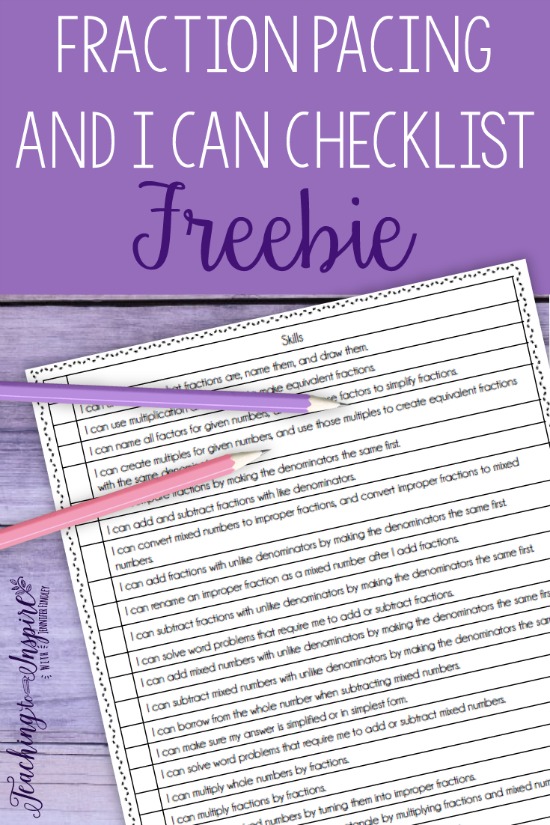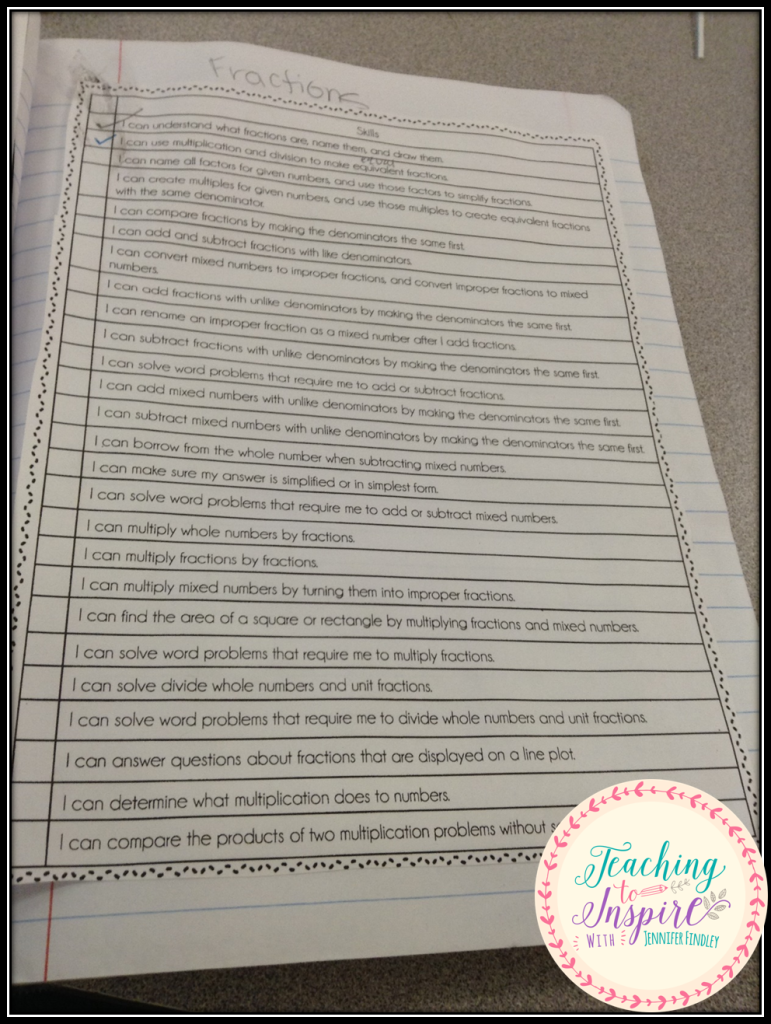Fractions..most either love them or hate them. I have a love/hate relationship with them. I love the models and how the skills can sometimes be made pretty concrete. I don’t love how all the skills build on each other and all the skills the students must have mastered to complete one problem. By the time the students get to 5th grade, if they have gaps in their fraction understandings, this presents a huge challenge. On this post, I will share a checklist that helped me break down the 5th grade fractions skills and the embedded ones from previous grades.

When I first started planning for our fraction unit, I spent some time breaking our standards down into “I Can” statements. However, I took it a step further and also wrote I Can Statements for all the pesky embedded skills. (You know those skills that the kids are supposed to come to 5th grade already knowing… 😉 ) The end result was kinda scary (not going to lie)! Take a look at all these skills…
- I can understand what fractions are, name them, and draw them.
- I can use multiplication and division to make equivalent fractions.
- I can name all factors for given numbers, and use those factors to simplify fractions.
- I can create multiples for given numbers, and use those multiples to create equivalent fractions with the same denominator.
- I can compare fractions by making the denominators the same first.
- I can add and subtract fractions with like denominators.
- I can convert mixed numbers to improper fractions, and convert improper fractions to mixed numbers.
- I can add fractions with unlike denominators by making the denominators the same first.
- I can rename an improper fraction as a mixed number after I add fractions.
- I can subtract fractions with unlike denominators by making the denominators the same first.
- I can solve word problems that require me to add or subtract fractions.
- I can add mixed numbers with unlike denominators by making the denominators the same first.
- I can subtract mixed numbers with unlike denominators by making the denominators the same first.
- I can borrow from the whole number when subtracting mixed numbers.
- I can make sure my answer is simplified or in simplest form.
- I can solve word problems that require me to add or subtract mixed numbers.
- I can multiply whole numbers by fractions.
- I can multiply fractions by fractions.
- I can multiply mixed numbers by turning them into improper fractions.
- I can find the area of a square or rectangle by multiplying fractions and mixed numbers.
- I can solve word problems that require me to multiply fractions.
- I can divide whole numbers and unit fractions.
- I can solve word problems that require me to divide whole numbers and unit fractions.
- I can answer questions about fractions that are displayed on a line plot.
- I can determine what multiplication does to numbers.
- I can compare the products of two multiplication problems without solving them.
After making the list (and getting over my feeling of being overwhelmed!), I did feel prepared, organized, and ready to tackle teaching the skills. I made copies for my kids which they glued in their math notebooks. Each time we learn (or review) a new skill, they check it off the list. Every now and then, we read over the list as a way to remind them of everything they have learned and need to remember to apply to fraction problems.
Here is a picture from a couple of weeks ago.
This is definitely keeping me focused and making sure I teach and assess all the standards and the embedded skills.
Click here or on the image below to grab a copy of the checklist.
5th Grade Fractions Pacing Information
The checklist is in the exact order and sequence that I pace and teach the skills to my students, so it doubles as a checklist and a detailed pacing. For more information about how I pace my math standards in 5th grade, click here.
As far as the time I allot for fractions, I spend about 8 weeks, depending on the needs of my students. I do spend an entire week reviewing all of the 3rd and 4th grade embedded skills from the checklist before moving on to 5th grade fractions skills. This allows me to ensure the foundation is strong and I have to do way less re-teaching as a result of spending this time upfront.
Do you need more 4th or 5th grade fraction resources for your classroom?
Click on the links below to check out a few recommended resources or articles for fractions.
4th Grade Fraction Review Mini-Booklet: I use this resource from my TeachersPayTeachers store before I teach 5th grade fraction skills. It allows me to quickly review 4th grade fraction skills and to make sure my students have the conceptual foundation needed.
Free Fraction Mats: I use these free downloadable fraction mats to support my students further as they add and subtract fractions with unlike denominators.
Four Ways to Make Common Denominators: This blog post shares the four ways I teach my students to make common denominators (free printable included).
Chocolate Themed Fraction Math Tasks: These tasks in my TeachersPayTeachers store are perfect for engaging fraction practice with a yummy chocolate theme.
Subtracting Mixed Numbers with Regrouping Resource: This TpT resource has a pizza theme and really helps my students conceptually understanding regrouping with mixed numbers.
Subtracting Mixed Numbers with Regrouping Using Manipulatives: This blog post shares three ways you have help your students subtract mixed numbers in a more concrete way using manipulatives.
Multiplying and Dividing Fractions: When you get ready to move on from adding and subtracting fractions, this is the perfect one stop resource for multiplying and dividing with fractions.
Free Basketball Fraction Review – This blog post shares details and a free printable for an engaging basketball themed fraction review that your students will love!
Free Jenga Fraction Game – Grab free printables to review fractions using colored Jenga blocks on this post. Your students will love this!
Free Fraction Dice Centers – Want some super low-prep games for your students to complete to review various fraction skills? This post shares several!








I am new to fifth grade and will be starting fractions soon. Your checklist will help keep me focused!!! Thanks for sharing.
Thanks. I will share this with my teaching partner.
Beti
Do you teach fractions in the order of this checklist? For example, beginning with NF.1 and working your way to NF.7, or do you do them in a specific order? I’m just wondering because in the past I’ve taught them in order and when done this way, NF.1 is a BEAST because, like you mentioned, all of the embedded skills: reducing, finding equivalents, being able to convert improper fractions, etc., just to be able to solver certain problems. This year I’m contemplating mixing the order up a bit, starting with NF.4, as this is basically converting improper fractions to mixed numbers, but I’m not sure where to go from there. Just wanted your input and what you do! 🙂
I actually do follow the order of the checklist. However, you could definitely start with NF.4 and go from there. I teach a lot of “at risk’ students so I actually have to start with 3rd grade Fraction Skills and go from there. If you do start with NF.4, then you could move from there to NF.1 and so forth. Fractions are a mess to teach anyway you look at it. 😀 Hope this helps!
I love your pacing guide and I can list for 5th grade.
Have you done similar ones for 3rd and 4th. I’m especially interested to hear what your feelings on the most critical fraction skills and concepts that 3rd graders need. As an remedial math teacher, I want to focus on the most critical concepts.
Thanks
Hi Nancy, I don’t have one for 3rd or 4th. However, I would definitely check out this video for important fraction skills and progression: https://gfletchy.com/2016/12/08/the-progression-of-fractions/
I would love to see more checklists like this for other standards. (Insert cheesy, pleading grin here.) Thank you in advance!
children based on the real-life https://www.youtube.com/watch?v=HHHcneIvIzA&t=10sstory of About Real-Life Kids Who Changed the World